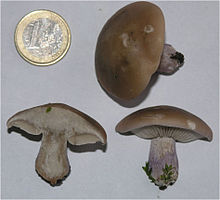- Lepista personata
-
Lepista personata Field blewit (Lepista personata) in its natural habitat Scientific classification Kingdom: Fungi Division: Basidiomycota Class: Basidiomycetes Order: Agaricales Family: Tricholomataceae Genus: Lepista Species: L. personata Binomial name Lepista personata
(Fr.) CookeSynonyms Lepista saeva
Clitocybe saeva
Tricholoma amethystinum
Tricholoma personatum
Tricholoma personatum f. minor
Tricholoma personatum var. anserina
Tricholoma personatum var. saevum
Tricholoma saevum
Rhodopaxillus personatus
Rhodopaxillus saevus
Agaricus anserinus
Agaricus personatus ß saevusLepista personata Mycological characteristics 
gills on hymenium 

cap is convex
or flat
hymenium is emarginate 
stipe is bare 
spore print is pink 
ecology is saprotrophic 
edibility: choice Lepista personata (also recognised as Lepista saeva and Clitocybe saeva, and commonly known as the field blewit and blue-leg) is a species of fungus. It is commonly found growing in grassy areas across Europe and is morphologically related to the wood blewit (Lepista nuda).
Contents
Taxonomy
This species was originally proclaimed by Elias Fries in 1818, as Agaricus personatus. Cooke proposed in 1871 another name still in us today — Lepista personata. Other names were to follow, namely Lepista saeva by P.D. Orton in 1960 and Clitocybe saeva by H.E. Bigelow & A.H. Smith in 1969, the latter placing the fungus in the larger genus Clitocybe.[1] In Latin, the specific epithet sævus is an adjective meaning either fierce, outrageous, angry or strong. Likewise, personatus is a participle meaning disguised, pretended or false.[2]
Description
The fruiting body of the mushroom resembles an agaric. The cap is at first hemispherical or convex, becoming almost flat with maturity, up to 16 cm in diameter. The cap cuticle is colored cream to light brown with a smooth texture to the touch, and is often seen glistening when fresh. Along the periphery, the cap ends in a thick incurved margin which may unfold as the mushroom expands. The white to pallid flesh is thick, firm and delicate upon slicing. The underside of the cap bears crowded pinkish, cream to light brown gills, which are free or emarginate in relation to the stem. The stem itself is cylindrical with a bulbous, or sometimes tapering base, and does not bear a ring. The stem is covered by a striking lavender or lilac-coloured fibrous skin which fades in older individuals, and has a thick, firm flesh concolorous with that of the cap. It is up to 6–7 cm tall and 2.5–3 cm in diameter.[3][4]
Under a light microscope, the spores are seen hyaline to pink, ellipsoid in shape, and with fine warts. The spore dimensions are 6-8 by 4-5 µm. L. personata produces a pale pink spore print.[3][4]
Distribution and habitat
Lepista personata is found fruiting in open grasslands, parks, pastures, forest clearings, and in the vicinity of forest edges, unlike Lepista nuda which is commonly found in woodland. Lepista personata fruits gregariously, forming distinctive fairy rings.[3][4] Its fruiting season extends from summer to the beginning of winter, and is widespread in Europe.[3] It has also been allegedly reported from California in North America.[5]
Edibility
Field blewits are generally regarded as edible, but they are known to cause allergic reactions in sensitive individuals. This is particularly likely if the mushroom is consumed raw, though allergic reactions are known even from cooked blewits.
Field blewits are often infested with fly larvae and don't store very well; they should therefore be used soon after picking. They are also very porous, so they are best picked on a dry day.[6]
In most mycologists' opinion, the field blewits are considered excellent mushrooms, despite their coloration. Blewits can be eaten as a cream sauce or sautéed in butter, but it is important not to eat them raw, which could lead to indigestion. They can also be cooked like tripe or as omelette filling.[6]
Footnotes
- ^ "Lepista personata taxon record details at Index Fungorum". CAB International. http://www.indexfungorum.org/Names/SynSpecies.asp?RecordID=445547. Retrieved November 15, 2009.
- ^ Jamieson A, Ainsworth R, Morell T. (1828). Latin dictionary: Morell's abridgment. London: Moon, Boys & Graves. pp. 400, 476. http://books.google.com/books?id=U3oTAAAAYAAJ&printsec=frontcover&dq=latin+dictionary&as_brr=3. Retrieved 2009-10-31.
- ^ a b c d Bas C. (1995). Flora Agaricina Neerlandica : Critical Monographs on Families of Agarics and Boleti Occurring in the Netherlands Vol. 3. CRC Press. p. 74. ISBN 9054106166. http://books.google.com/books?id=NGGiXsS9eYwC&pg=PA67&dq=neerlandica+saeva&lr=#v=onepage&q=saeva&f=false. Retrieved 2009-11-13.
- ^ a b c Yordanov L., Vanev S., Fakirova V. (1978). The Fungi in Bulgaria (Гъбите в България). Sofia: Bulgarian Academy of Sciences. p. 182.
- ^ Arora, David. (1986). Mushrooms Demystified. Berkeley, CA: Ten Speed Press. ISBN 0898151694
- ^ a b Mabey, Richard (2004). Food for Free. HarperCollins. ISBN 0007183038.
External links
Categories:- Edible fungi
- Lepista
- Tricholomataceae
- Fungi of Europe
- Fungi naturalized in Australia
- Fungi found in fairy rings
Wikimedia Foundation. 2010.


